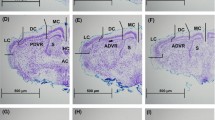Abstract
This study was designed to compare catecholamine concentrations among three brain areas of four pureline populations of visually isolated chicks. The purelines used were a commercial male line, a fertility selected line, an unselected fertility control line, and unselected White Jersey Giants. In general, male chicks had significantly larger brain weights than females. Six catecholamine-related compounds (norepinephrine, epinephrine,l-DOPA, dopamine, DOPAC, and MHPG) were measured via HPLC-ECD. No significant differences in neurochemical concentration were observed for any line or brain area due to sex of the chick. The hypothalamus (HT) contained the greatest concentration of catecholamines in all lines, followed by the intramedial hyperstriatum ventrale (IMHV) and optic tectum (OT). The HT exhibited consistent lateralization in all lines with the right HT containing ca. 30% more catecholamines than the left HT. While no consistent lateralization was observed among the other brain areas, the IMHV exhibited significantly different degrees of lateralization among the populations. Neuronal activity, as measured by MHPG:NE and DOPAC:DA ratio varied by line within each brain area. There were line differences for MHPG:NE in the HT, IMHV, and OT, while line differences for DOPAC:DA were observed in the HT. Since differences among purelines have been demonstrated in this study, care must be given to precisely define the genotype of chicks used in behavioral and neurochemical research.
Similar content being viewed by others
References
Mason, S.T. 1984.Catecholamines and Behavior, Cambridge University Press, New York.
Bateson, P.P.G., Horn, G., and Rose, S.P.R. 1975. Imprinting: correlations between behavior and incorporation of [14C]uracil into chick brain. Brain Res. 84:207–220.
Kohsaka, S., Takamatsu, K., and Tsukada, Y. 1979. Metabolic mapping of chick brain after imprinting using [14C]2-deoxyglucose technique. Brain Res. 172:539–544.
Bradley, P., Horn, G., and Bateson, P. 1981. An electron microscopic study of the chick hyperstriatum ventrale. Exp. Brain Res. 41:115–120.
Rogers, L.J. 1982. Light experience and asymmetry of brain function in chickens. Nature 297:223–225.
Rose, S.P.R. 1991. Biochemical mechanisms involved in memory formation in the chick.In R.J. Andrew (ed.)Neural and Behavioral Plasticity: The Use of the Domestic Chick as a Model, Oxford Press, New York, (in press).
Konishi, M., Emlen, S.T., Ricklefs, R.E., and Wingfield, J.C. 1989. Contributions of bird studies to biology. Science 246:465–472.
Mason, R.J., and Rose, S.P.R. 1988. Passive avoidance learning produces focal elevation of bursting activity in the chick brain: Amnesia abolishes the increase. Behav. and Neural Biol. 49:280–292.
Gibbs, M.E., and Ng, K.T. 1977. Psychobiology of memory: Towards a model of memory formation. Biobehav. Rev. 1:113–136.
Davies, D.C., Horn, G., and McCabe, B.J. 1983. Changes in telencephalic catecholamine levels in the domestic chick. Effects of age and visual experience. Dev. Brain Res. 10:251–255.
Graves, H.B., and Siegel, P.B. 1968. Chick's response to an imprinting stimulus: Heterosis and evolution. Science 160:329–330.
Graves, H.B., and Siegel, P.B. 1969. Bidirectional selection for responses ofGallus domesticus chicks to an imprinting situation. Anim. Behav., 17:683–691.
Barbato, G.F., and Vasilatos-Younken, R. 1991. Maternal and sex-linked effects on growth in chickens. Poultry Sci. 70:in press.
Kuenzel, W.J., and Masson, M. 1988. A Stereotaxic Atlas of the Brain of the Chick (Gallus domesticus). Johns Hopkins University Press, Baltimore.
McKay, L., Bradberry, C., and Oke, A. 1984. Ascorbic acid oxidase speeds up analysis for catecholamines, indolamines and their metabolites in brain tissue using high-performance liquid chromatography with electrochemical detection. J. Chromatogr. 311:167–169.
Markwell, M.A.K., Haas, S.M., Tolbert, N.E., and Bieber, L.L. 1981. Protein determination in membrane and lipoprotein samples: Manual and automated procedures. Methods in Enzymology 72:296–303.
Barbato, G.F. 1990. A fast HPLC analysis of catecholamines and indoleamines in avian brain tissue. J. Liq. Chromatog. 13:2553–2560.
Freund, R.J., Littel, R.C., and Spector, P.C. 1986. SAS systems for linear models. SAS Institute Inc. Cary, NC. pp. 101–113.
Shanawany, M.M. 1987. Hatching weight in relation to egg weight in domestic birds. World's Poultry Sci. 43:107–115.
Anthony, N.B., Jones, D.E., Dunnington, E.A., Emmerson, D.A., and Siegel, P.B. 1991. Allometric growth and DNA, RNA and total protein of brains from White Rock chickens selected for 56-day body weight. J. Anim. Breed. and Genet. 107:in press.
Adret, P., and Rogers, L.J. 1989. Sex difference in the visual projections of young chicks: a quantitative study of the thalamofugal pathway. Brain Res. 478:59–73.
House, D., Berman, E., and Carter, H.B. 1985. Description and implication for analysis of brain growth in suckling mice. Growth 49:426–438.
Callingham, B.A., and Sharman, D.F. 1970. The concentration of catecholamines in the brain of the domestic fowl (Gallus domesticus). Br. J. Pharmac. 40:1–5.
Juorio, A.V., and Vogt, M. 1967. Monoamines and their metabolites in the avian brain. J. Physiol. 189:489–518.
Ciaranello, R.D., Barchas, R., Kessler, S., and Barchas, J.D. 1972. Catecholamines: Strain differences in biosynthetic enzyme activity in mice. Life Sci. 11:565–572.
Lorden, J.F., and Oltmans, G.A. 1977. Hypothalamic and pituitary catecholamine levels in genetically obese mice (obob). Brain Res. 131:162–166.
Patterson, T.A., Gilbert, D.B., and Rose, S.P.R. 1990. Pre- and post-training lesions of the intermediate medial hyperstriatum ventrale and passive avoidance learning in the chick. Exp. Brain Res. 80:189–195.
Kasamatsu, T., Pettigrew, J.B. and Ary, M., 1979. Restoration of visual cortical plasticity by local microperfusion of norepinephrine. J. Comp. Neurol. 185:139–162.
Hartmann, W. 1988. From Mendel to multi-national in poultry breeding. Br. Poult. Sci. 29:3–26.
Author information
Authors and Affiliations
Rights and permissions
About this article
Cite this article
Kruzelock, R.P., Barbato, G.F. Genotype differences in catecholamine concentrations in hypothalamus, intramedial hyperstriatum ventrale, and optic tectum of newly hatched chicks. Neurochem Res 16, 105–112 (1991). https://doi.org/10.1007/BF00965696
Accepted:
Issue Date:
DOI: https://doi.org/10.1007/BF00965696




